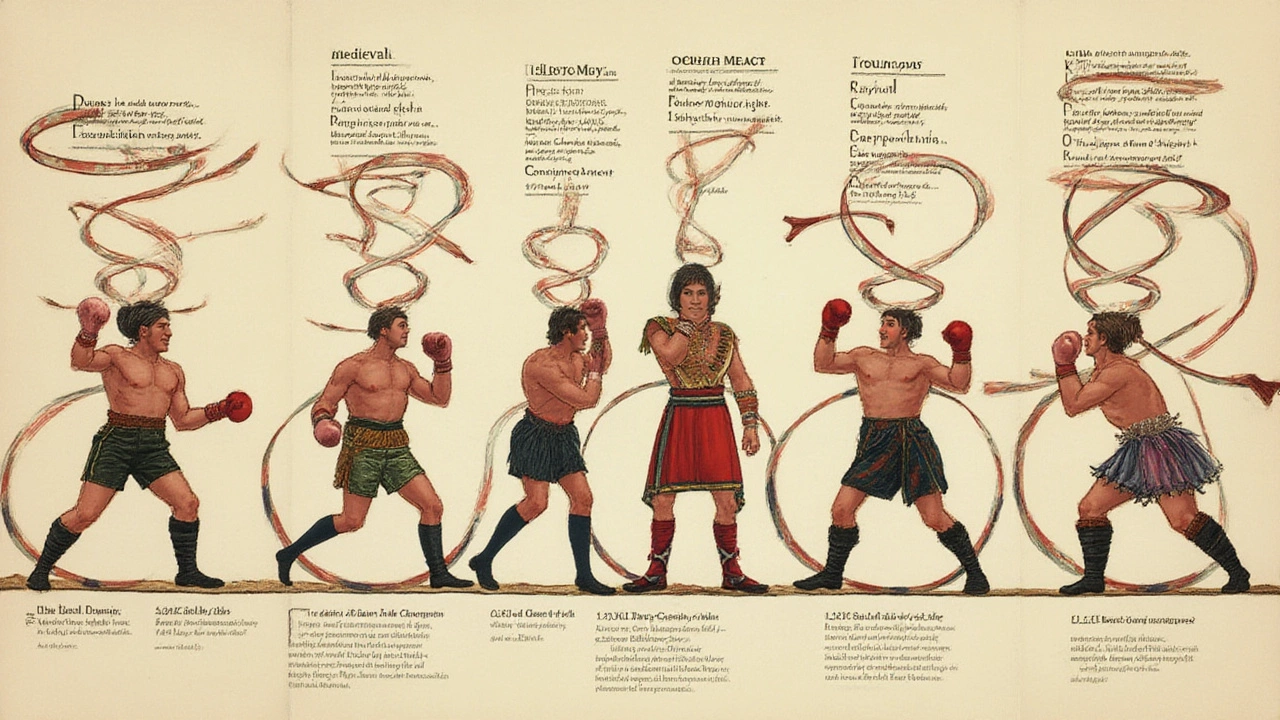Boxing Bout Explained: What Is a Boxing Match Called and Why?

Ever caught a boxing commentator call it a “bout” and felt a flicker of confusion about what that means? Boxing has its fair share of quirky jargon, but this particular term actually goes way back in history. When you hear “bout,” it’s more official than simply calling it a fight or a match—and there’s a story here that’s as punchy as the sport itself.
What Does ‘Bout’ Mean in Boxing?
The term “bout” is a staple in the world of boxing. Simply put, a boxing match is officially called a bout. You’ll hear this in Olympic broadcasts, amateur gym circles, and in the roaring stadiums of Las Vegas. But why do they use this word instead of just saying ‘fight’ or ‘match’? The answer lies in the roots of boxing tradition and the evolution of language around the sport.
Boxing adopted “bout” from the old French word ‘bouter,’ meaning to push or to thrust. It showed up in English centuries ago to describe a contest or a round of combat, not just in boxing but also in wrestling and fencing. Over the decades, while the word ‘fight’ took on a general flavor (think street fights or any scuffle), “bout” took a more official turn, especially in the world of organized sports. By the late 19th century—think Jack Johnson’s era—the word “bout” was already entrenched in the era’s sports reporting. The phrase gave the sport a sense of structure, formality, and a scheduled nature. This is why, from local amateur gyms in Bristol to the glitzy halls of Madison Square Garden, you’ll see the term “bout” used to refer to a boxing match with specific rules, rounds, and regulations.
To give context, every sanctioned boxing event, whether amateur or professional, divides its schedule into multiple bouts. Each bout pits two boxers against each other for a set number of rounds—these days, typically anywhere from 4-round undercard bouts to the 12-round championship showdowns. In Olympic boxing, the term carries extra weight because each bout is crucial for progressing through the brackets. If you skim through the official rules put out by the British Boxing Board of Control or the International Boxing Association, you’ll see “bout” pop up dozens of times—never “fight.” In those circles, “fight” is informal, while “bout” is written into contracts, schedules, and scorecards.
So if you’re discussing boxing with someone who knows the ropes, calling a boxing match a “bout” not only sounds right—it is right. You’ll also hear the word when referring to clashes in mixed martial arts, fencing, and wrestling, but boxing holds on to it with particular pride. And if you’re ringside at a local match, it’s hard not to hear the officials say, “This bout is scheduled for six rounds.” They’d never say, “This fight…” because, in their world, a “fight” can break out anywhere, but only boxers step into a sanctioned “bout.”

The Anatomy of a Boxing Bout
But what actually happens in a boxing bout, and what sets it apart from just a generic fight? Here’s where boxing’s love of structure really stands out. Every bout, no matter the level, has a clear set of rules and a format that goes far beyond two people throwing punches in a ring.
Let’s break down the bones of a boxing bout. First, you’ve got two fighters, matched by weight class (for example, heavyweight or featherweight), along with a referee, three judges, timekeepers, and official scorers. Before the first punch is thrown, the bout has already been meticulously planned right down to the length of rounds, the minutes of rest between rounds, and the gloves’ weight. Here’s a quick look at standard professional boxing rules:
- Bouts typically run for a set number of rounds. Most professional bouts are 4, 6, 8, 10, or 12 rounds, each lasting three minutes (except in some women’s bouts, which can be two minutes per round).
- Between each round, fighters rest for one minute in their corners, attended by their trainers.
- If neither competitor is knocked out, judges score each round, and the winner is decided by points.
- A bout can end in a knockout (KO), technical knockout (TKO), disqualification, or a decision based on the judges’ scorecards. Rarely, it can end in a draw.
Now, consider this—during a professional bout in the UK, you’ll spot scorecards, gloves, banners, and even referee reports all using the word “bout.” For amateur events under the England Boxing umbrella, the word dominates entry forms and bout sheets. In contrast, “fight” is something you’ll hear in the stands, on the underground scene, or after a few pints at the local—never in the official lingo.
Bouts are also numbered in each boxing event. For example, the schedule might list “Bout 3: Smith vs. Perez,” which strictly refers to the third scheduled match of the evening. And if you’re sitting with the officials, almost every document you flip through will use “bout” as the core description. It goes deeper too—stats compiled by BoxRec, one of the sport’s definitive databases, sort athletes’ records by ‘bouts’ participated, won, lost, or drawn. When you’re next browsing a boxer’s career stats, that “Total Bouts” column is the real deal—the final count of all matches fought under sanctioned rules.
Curious about how often boxers face off? Here’s a handy table with the average number of bouts for active professional boxers based on their career stage:
| Career Stage | Average Bouts Per Year | Total Bouts in 5 Years |
|---|---|---|
| Early career (Years 1-2) | 4-5 | 8-10 |
| Prime years (Years 3-7) | 2-3 | 10-15 |
| Late career (Years 8+) | 1-2 | 5-10 |
Of course, every boxer is different—some rack up 50 bouts in a career, while others get legendary status after just a dozen. Yet, each scheduled and successfully completed boxing “bout” counts as a significant official event on their record. These numbers only represent sanctioned, officially recognized bouts, leaving out exhibition matches or unsanctioned fights.
The structure of a boxing bout has traditions that aren’t just about the rules. The word is also used in legal contracts and in sports law: for instance, if a show is promoted in Bristol, the promotional documents will read that ‘bouts’ will be contested under the supervision of the official body. Even the media—Look out for BBC Sport or Sky Sports coverage—they’ll keep the word “bout” in the text when referring to the scheduled contest.

When Should You Use the Word ‘Bout’ Instead of Match or Fight?
Knowing when to use “bout” can be the difference between sounding like a casual fan and someone who’s in the know. Here’s a practical tip: always use “bout” when you’re talking about an official, scheduled, and sanctioned boxing event. If you’re chatting to a coach, a judge, or someone in the regulatory side of boxing, that’s your word. Legal contracts, tickets, promotional posters, TV listings—all will say “bout.” Want to be taken seriously as a knowledgeable spectator? Using the right word goes a surprisingly long way.
The use of “match” is not totally wrong, but it lacks the technical punch of “bout.” “Match” is more universal, used across tennis, football, or cricket, and doesn’t capture the particular structure of a scheduling in boxing, where multiple bouts can take place in one event. Call it a match in a casual pub chat, and nobody will call you out—but bring up a “bout” and eyes will light up with recognition that you know the lingo.
“Fight” is the least formal of the bunch. Outside the ring, “fight” can mean anything from a playground scrap to a spat between football fans. In boxing, calling it a fight strips away the discipline and strict regulation built into the sport over generations. That’s why you’ll probably notice pro boxers and commentators reserving “fight” for marketing hype (think, “The Fight of the Century!”) but “bout” for all the nuts-and-bolts paperwork and formal recognition.
One neat fact: In some traditions, like Japanese boxing, the word “bout” also appears in both Japanese-English media and rulebooks. Even in Spanish texts, you’ll see “combate” (which translates closely to bout) used, showing the global sense of the term. Online, massive fight databases like Tapology or BoxRec always call it a “bout,” reserving “match” strictly for match-making before an event is confirmed.
If you’re interested in the etiquette—at a boxing gym in Bristol or anywhere in the UK—using “bout” also shows respect for the discipline of the sport. Coaches and ring officials appreciate when someone asks, “How many bouts tonight?” rather than, “How many fights?”. It’s one of those details that separates curious onlookers from people invested in boxing’s unique world.
- If you see “bout” on a schedule or poster, you know it’s an officially recognized contest, not an informal scrap.
- On official scorecards, “bout” is the term for the event; even ring announcements use the phrase (“This bout is scheduled for ten rounds…”).
- Want to impress at your next boxing watch party? Drop “bout” into the conversation when discussing which match is up next!
- Remember, “match” can mean almost any sport, but “bout” is deeply woven into boxing history and culture.
For anyone just getting into boxing, tuning into the correct language is not just about accuracy—it’s about becoming part of the fabric of the sport. Whether you’re heading to a local bout in Bristol, streaming a world championship, or having a go yourself in the gym, knowing why it’s called a bout helps you connect with the sport’s roots and its global community of fans and athletes.
Boxing’s love of the word “bout” reveals just how much respect the sport has for tradition and discipline. So next time you’re ringside, at the pub, or glued to a pay-per-view event, remember—when the bell rings and the two boxers meet in the center, what you’re watching isn’t just a fight or a match. It’s a bout—part of boxing’s unique language and its rich, enduring legacy.
